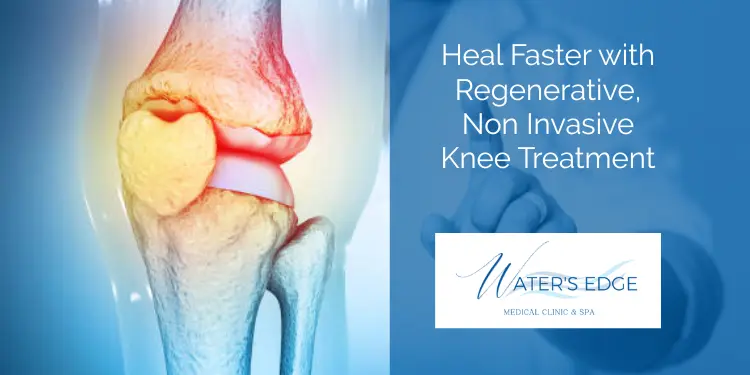Knee pain can really slow you down. When you’re dealing with aches and stiffness, it’s natural to look for solutions that help you heal without the hassle of surgery. Luckily, there are options out there—like Non Invasive Knee Treatment —that use your body’s own healing power. These non-invasive treatments are becoming more popular because they aim to fix the problem at its source, helping you get back to your daily life with less risk and downtime.
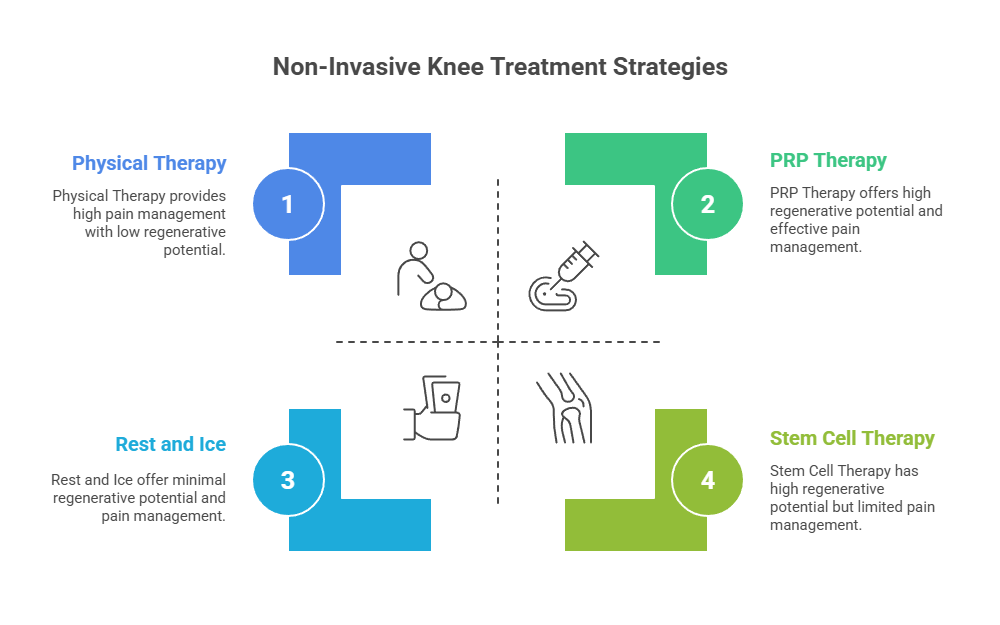
Key Takeaways
- Non-invasive knee treatments focus on using your body’s natural healing abilities to repair damage and reduce pain without surgery.
- Regenerative medicine techniques like PRP and stem cell therapy can help with conditions such as osteoarthritis, ligament tears, and tendonitis.
- These treatments offer a way to potentially avoid surgery, reduce recovery time, and manage knee pain effectively.
What Is Non Invasive Knee Treatment and How Does It Work?
What is Non-Invasive Knee Treatment?
Non-invasive knee treatment refers to medical approaches that aim to heal knee injuries and conditions without the need for surgery. Instead of cutting into the body, these methods focus on using the body’s own natural healing capabilities to repair damaged tissues. This often involves using regenerative medicine techniques to encourage tissue growth and reduce inflammation, offering a gentler path to recovery.
How Does It Work?
These treatments typically work by harnessing the power of your body’s own healing components. For instance, Platelet-Rich Plasma (PRP) therapy involves drawing a small amount of your blood, concentrating the platelets and growth factors, and then injecting this concentrated solution back into your knee. These platelets then signal the body to send healing cells to the area, promoting repair. Similarly, stem cell therapy uses stem cells, which have the potential to develop into various cell types, to help regenerate damaged cartilage and tissue.
The key is precise delivery, and knowing which regenerative product to inject based off of degeneration or damage in the affected joint. The goal is to stimulate your body’s natural repair processes, reduce pain, and improve function without the trauma and risks associated with surgery.
Key Regenerative Techniques
- Platelet-Rich Plasma (PRP) Therapy: Uses concentrated platelets from your own blood to promote healing.
- Stem Cell Therapy: Utilizes stem cells to help regenerate damaged tissues, including cartilage.
- Prolotherapy: Involves injecting a solution to stimulate a localized healing response in ligaments and tendons.
Benefits Over Surgery
Choosing non-invasive treatments can mean avoiding the significant downsides of surgery, such as long recovery times, the risk of infection, and the potential for complications from anesthesia. Many patients find that these regenerative approaches offer a way to manage pain and improve mobility with less downtime and fewer risks. It’s about working with your body’s inherent ability to heal, rather than overriding it with invasive procedures. For many, this means getting back to daily activities sooner and with less discomfort. You can explore options like stem cell therapy for knee cartilage as a prime example of this approach.
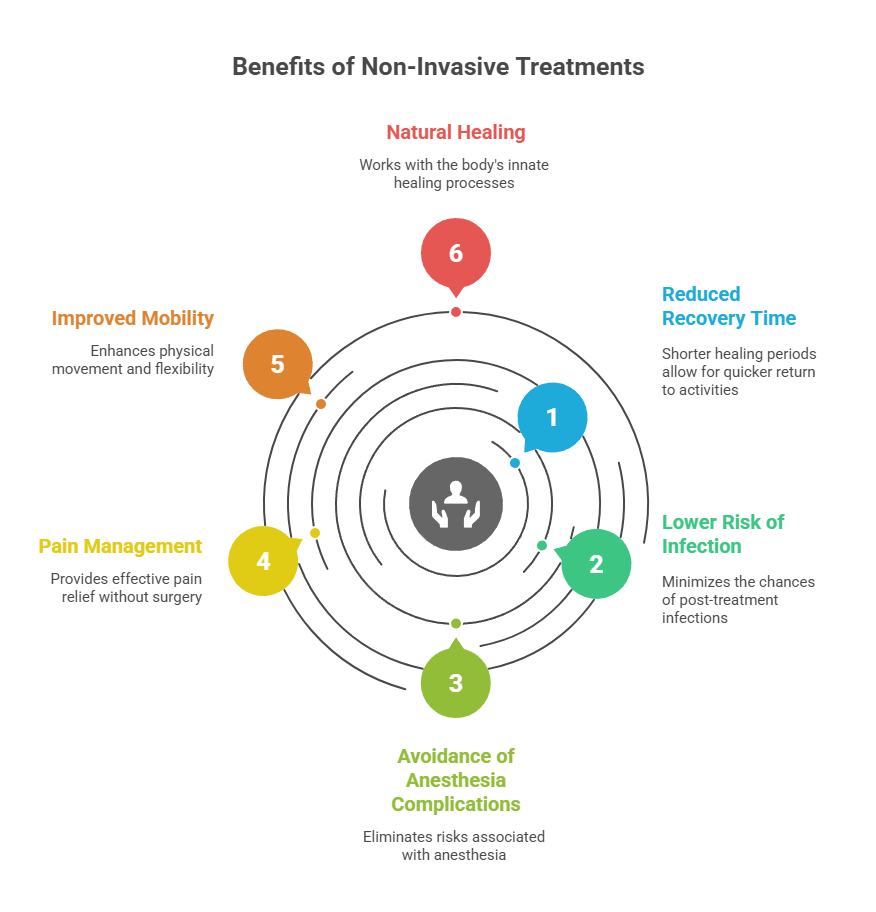
When to Consider Non-Invasive Treatment
If you’re experiencing knee pain due to conditions like osteoarthritis, ligament sprains, or tendonitis, and you’re looking for alternatives to surgery, non-invasive regenerative treatments are worth exploring. They are particularly beneficial for individuals who want to avoid the risks of surgery or who haven’t found relief with more traditional methods. It’s a way to address the root cause of the pain by promoting actual tissue repair.
Benefits of Choosing Non Invasive Knee Treatment Over Surgery
Choosing a non-invasive knee treatment over surgery can lead to a smoother recovery and fewer complications. Many people find that avoiding surgery means less downtime, which is a big plus if you have a busy life. You can often get back to your regular activities much faster. Plus, there’s generally less pain involved compared to going under the knife.
Reduced Risk of Complications
Surgery, even when successful, always comes with some risks. These can include infection, blood clots, or reactions to anesthesia. Non-invasive treatments typically have a much lower risk profile. This means you can focus on healing without worrying as much about these potential issues. It’s a gentler approach to getting your knee better.
Faster Recovery Times
One of the most appealing aspects of non-invasive treatments is the speed at which people can often recover. Instead of weeks or months of intense physical therapy and rest after surgery, many regenerative procedures allow for a quicker return to daily life. Some patients even report feeling better within days or weeks, not months. This is a significant advantage for anyone who can’t afford to be sidelined for too long. You might be able to resume light activities sooner than you think.
Less Scarring and Pain
Surgical procedures, by their nature, involve incisions, which naturally lead to scarring. Non-invasive methods, on the other hand, usually don’t require stitches or significant cuts. This means less visible scarring and often less post-procedure discomfort. The goal is to heal your knee from the inside out, minimizing external trauma. This can make the whole experience much more pleasant.
Avoiding the Risks of Anesthesia
Anesthesia is a necessary part of surgery, but it does carry its own set of risks, especially for individuals with certain health conditions. Non-invasive treatments are typically performed without the need for general anesthesia, or at most, with local anesthetic. This bypasses the potential complications associated with anesthesia, making the treatment accessible to a wider range of patients. It’s a way to get effective treatment without the added concerns of anesthesia.
Preserving Natural Joint Function
Some surgical interventions, while aiming to fix a problem, can sometimes alter the natural mechanics of the knee joint. Regenerative, non-invasive treatments focus on stimulating your body’s own healing processes to repair damaged tissues. This approach aims to restore function and strength naturally, potentially preserving the joint’s original structure and movement for longer. It’s about working with your body, not against it. This can be a key factor in long-term joint health. You can explore options like SoftWave Therapy to understand more about these regenerative journeys.
Lower Overall Cost
While the upfront cost of some regenerative treatments might seem comparable to surgery, the overall financial picture often favors non-invasive options. Consider the reduced need for extensive post-operative care, fewer medications, and a quicker return to work. These factors can significantly lower the total expense associated with recovery. It’s a more economical path to knee health for many people. You might find that avoiding surgery leads to substantial savings over time, making it a more practical choice for your knee health.
Types of Non Invasive Knee Procedures That Use Regenerative Medicine
Platelet-Rich Plasma (PRP) Therapy
Platelet-Rich Plasma (PRP) therapy is a cutting-edge regenerative treatment that harnesses your body’s own healing power. The process begins with drawing a small amount of your blood, similar to a standard blood test. This blood is then placed in a centrifuge, which spins it at high speeds to separate and concentrate the platelets and growth factors. These concentrated platelets are then carefully injected into the damaged knee joint, often with the aid of imaging guidance for precision.
The concentrated platelets release growth factors that signal and support the body’s natural repair mechanisms, helping to reduce inflammation and promote tissue regeneration. This approach is frequently used for conditions like osteoarthritis, tendonitis, and certain ligament injuries.
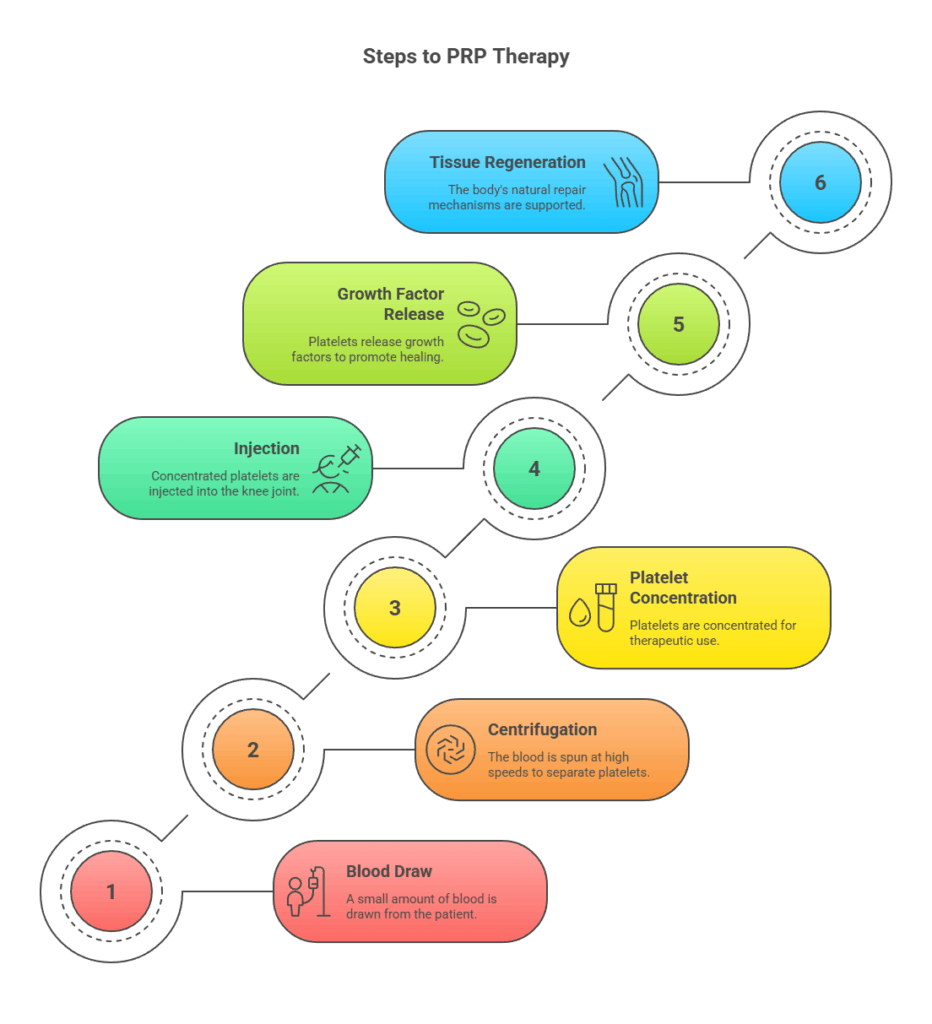
Stem Cell Therapy
Stem cell therapy is another powerful regenerative option for knee pain. The stem cells are unique because they have the potential to develop into various cell types, including cartilage and ligament cells. In this procedure, mesenchymal stem cells are received from an FDA certified lab.
The cells are harvested from the Whartons jelly of the umbilical cord. These cells are then injected into the affected knee. Once in the joint, they can differentiate into the types of cells needed to repair damaged tissues, potentially regenerating cartilage and other structures. This therapy is considered for more significant joint degeneration and injuries.
Prolotherapy
Prolotherapy, also known as regenerative injection therapy, involves injecting a mild irritant solution, typically dextrose (a form of sugar), into the damaged or weakened ligaments and tendons around the knee. This controlled irritation triggers a localized inflammatory response, which in turn stimulates the body’s natural healing processes. Over time, this can lead to the strengthening and repair of the affected tissues. Prolotherapy is often used for chronic ligament laxity and joint instability. It’s a treatment that encourages your body to heal itself, often requiring a series of treatments for optimal results.
These non invasive knee procedures represent a significant shift from traditional surgical interventions, focusing on stimulating the body’s inherent ability to repair and regenerate damaged tissues. They offer a less invasive path to recovery and pain relief for many individuals suffering from knee ailments.
Who Can Benefit from Non Invasive Knee Treatment?
Many individuals experiencing knee discomfort or seeking alternatives to surgery can find relief through non-invasive, regenerative treatments. If you’ve been told that surgery or steroid injections are your only recourse, it’s worth exploring these newer options. These therapies are designed to work with your body’s natural healing processes.
Conditions Commonly Addressed
Non-invasive treatments can be effective for a range of knee issues, including:
- Osteoarthritis: Helping to reduce pain and improve joint function.
- Ligament Injuries: Supporting the healing of tears and sprains.
- Tendonitis: Alleviating inflammation and pain in tendons around the knee.
- Chondromalacia Patella: Addressing pain and potential cartilage softening.
- Bursitis: Reducing inflammation in the fluid-filled sacs around the knee.
Who Should Consider These Treatments?
- Individuals with mild to moderate knee pain: Those whose pain doesn’t severely limit daily activities but is persistent.
- Patients seeking to avoid surgery: People who want to postpone or entirely bypass invasive surgical procedures and their associated recovery times.
- Athletes and active individuals: Those looking to recover from sports-related injuries and return to their activities without extensive downtime.
- People who haven’t responded to conservative treatments: Individuals who have tried physical therapy or other non-surgical methods without significant improvement.
It’s important to remember that while these treatments offer a promising path for many, they are not a universal solution. A thorough evaluation by a qualified healthcare provider is necessary to determine if you are a suitable candidate. They can assess your specific condition and discuss the potential benefits and outcomes tailored to your needs. Many people find relief through these methods, avoiding the risks and recovery associated with surgery. You can explore options for non-surgical knee treatment near me to find qualified practitioners in your area.
While surgery might seem like the only answer for persistent knee pain, advancements in regenerative medicine offer a different approach. These methods aim to heal damaged tissues from within, potentially offering a less disruptive path to recovery and improved knee function.
How to Find Non Surgical Knee Treatment Near Me
When you’re experiencing knee pain, the thought of finding the right treatment can feel overwhelming. You’re likely looking for effective non surgical knee treatments that can provide lasting relief without the risks associated with surgery. The good news is that many options are available, and locating them is more straightforward than you might think. Focusing your search on “non surgical knee treatment near me” is a smart first step.
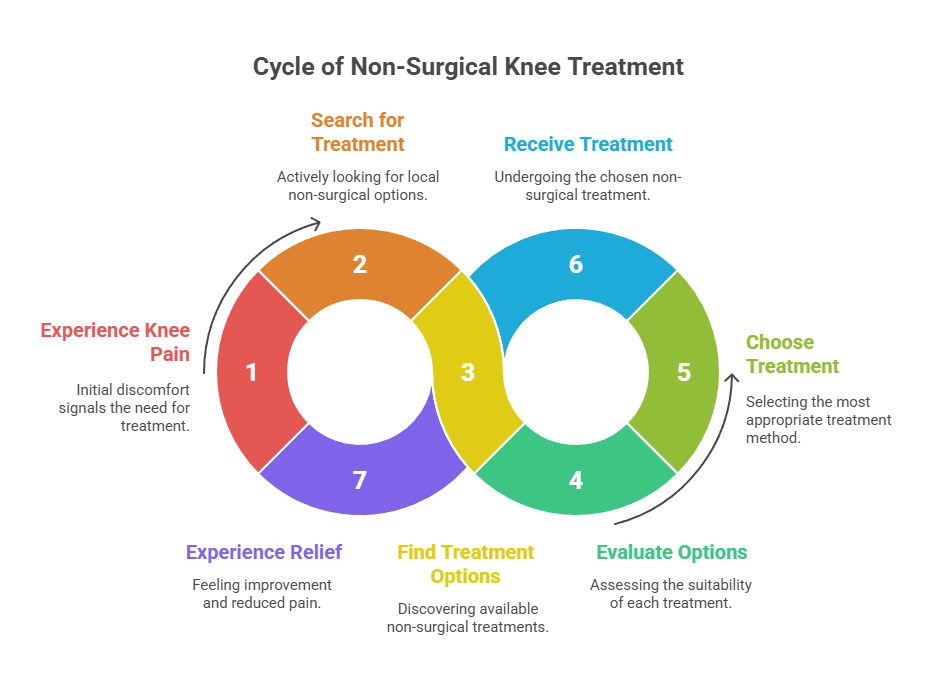
Consult Your Primary Care Physician
Your first point of contact should often be your regular doctor. They can assess your knee pain, discuss your medical history, and provide an initial diagnosis. Based on this, they can refer you to specialists or recommend specific non-surgical approaches. This initial consultation is key to understanding the root cause of your discomfort.
Seek Out Specialists in Regenerative Medicine
Many clinics now focus on regenerative medicine, which uses your body’s natural healing capabilities. These specialists often employ techniques like Platelet-Rich Plasma (PRP) therapy or stem cell injections. These methods aim to repair damaged tissues and reduce inflammation, offering a path to non surgical knee pain relief. When searching, look for practices that highlight their experience with these advanced treatments.
Explore Physical Therapy Options
Physical therapy is a cornerstone of non-surgical knee care. A skilled physical therapist can design a personalized exercise program to strengthen the muscles around your knee, improve flexibility, and increase your range of motion. They can help you regain function and reduce pain, often making surgery unnecessary. You can find physical therapists through your doctor’s referral or by searching online directories.
Utilize Online Resources and Directories
When looking for “non surgical knee treatment near me,” online searches are incredibly useful. Websites dedicated to medical providers or specific treatments can help you find clinics and practitioners in your area. Reading patient reviews and checking the credentials of potential providers can also guide your decision. For example, you might find a clinic like Waters Edge that specializes in natural and regenerative pain relief.
Consider Your Treatment Goals
It’s important to have a clear idea of what you hope to achieve. Are you looking to reduce pain, improve mobility, or return to a specific activity? Discussing these goals with your healthcare provider will help determine the most suitable non-surgical approach for your unique situation. Understanding the different types of non-invasive procedures that use regenerative medicine can help you make an informed choice about your knee health.
Looking for ways to ease knee pain without surgery? You’re in the right place! Many people find relief through non-surgical treatments. These options can help you get back to doing the things you love. Discover how you can find the best non-surgical knee care close to home.
Moving Forward with Confidence
So, if you’re dealing with knee pain, remember there are options beyond surgery. Treatments like PRP and stem cell therapy are changing how we approach joint health. They work with your body’s own healing power, aiming to get you back to doing the things you enjoy without the long recovery or risks of an operation. It’s definitely worth talking to a doctor about these regenerative methods to see if they could be the right fit for you. You might be surprised at how much better you can feel.
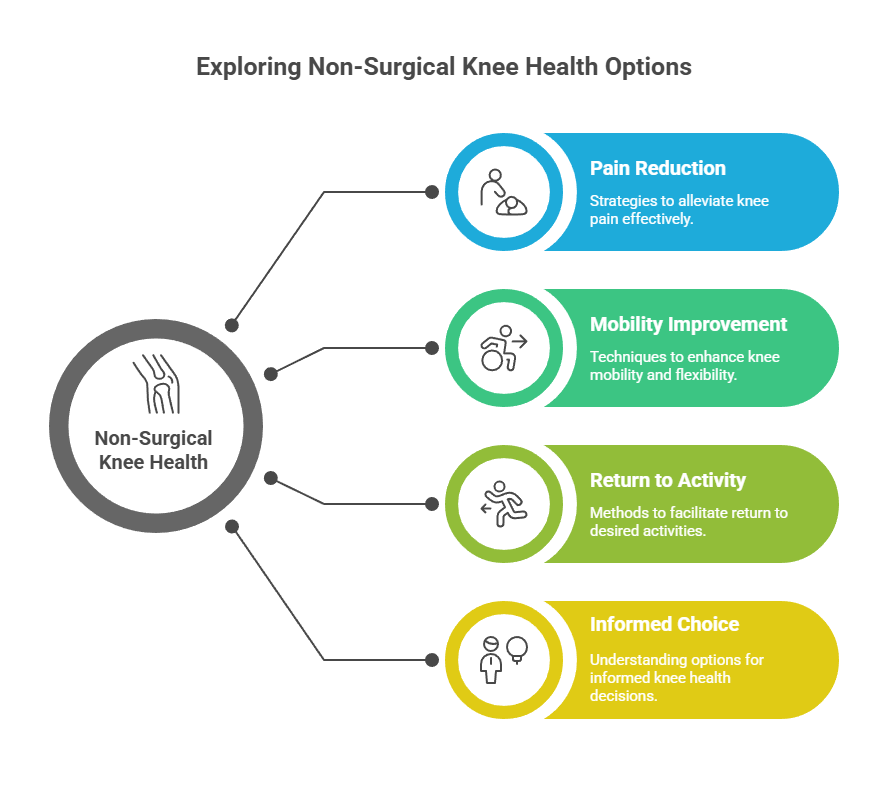
Frequently Asked Questions

What exactly is non-surgical knee treatment?
Non-surgical knee treatments use your body’s own healing power to fix knee problems. Instead of cutting into the knee, doctors use things like special injections made from your own blood (Platelet-Rich Plasma or PRP) or stem cells. These treatments help repair damaged tissues, reduce swelling, and ease pain, allowing you to heal naturally and often faster than with surgery.
Who is a good candidate for these types of knee treatments?
Many people with knee pain from things like arthritis, old injuries, or just wear and tear can benefit. If you’re looking for a way to avoid surgery, want a quicker recovery, or prefer a treatment that doesn’t involve heavy medication, these methods might be a good fit. It’s always best to talk to a doctor to see if it’s right for your specific situation.
How do these regenerative treatments help the knee heal?
The goal is to help your body heal itself. Treatments like PRP use concentrated platelets from your blood, which have special healing ingredients. Stem cell therapy uses cells that can turn into different types of tissue to help repair damage. Prolotherapy uses a mild irritant to kickstart your body’s natural healing response. These methods aim to reduce pain and improve how well your knee works without surgery.
If you have any additional questions or if you would like to see if regenerative medicine is right for you, please contact us at Waters Edge Medical Clinic 727-550-0855 and receive a free consultation and evaluation.

